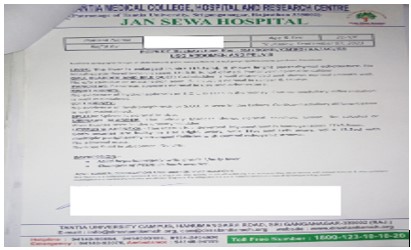An Ayurvedic methodology for managing PCOD - A Case Report
DOI:
https://doi.org/10.21760/jaims.9.4.51Keywords:
PCOD, Aratava Kshaya, Sroto-Dusti, AnovulationAbstract
Polycystic ovarian disease (PCOD) is a heterogenous endocrine disorder characterized by ovarian cysts, anovulation, and hormonal fluctuations, impacting women’s health in various ways. PCOD has transformed into a lifestyle disorder due to sedentary habits, excessive consumption of fast food, and an unhealthy lifestyle. Predisposing risk factors such as genetics, neuroendocrine factors, lifestyle and environmental influences, as well as obesity, play significant roles in the development of PCOD. In Ayurveda, PCOD cannot be correlated to any one particular disease; it can be related to certain diseases like Vandhya, Nasthartava, Aratava Kshaya, Pushpaghni Jataharini, etc. and must be controlled according to the Dosha Dushya vitiation. In this present case study, a 21 year old female patient came with symptoms of scanty menses, acne over face and weight gain in the OPD of Kayachikitsa. The USG report reveals PCOD changes in both ovaries as both ovaries are bulky in size right ovary, vol = 18cc and left ovary, vol = 13.2cc with multiple peripherally arranged follicles with central echogenic stroma. The result was determined based on the relief of clinical symptoms and the findings from the ultrasound report. Therefore, in this case study, drugs such as Dashmool Kwath, Narikanti, Cystogrit diamond etc. was given which have Lekhaniya properties results into reducing the size of ovary and effectively alleviate Kapha Dosha and Ama, facilitating the treatment of Sroto-Dusti and removing obstructions caused by Apana Vayu, ultimately enhancing menstrual flow.
Downloads
References
Sheth, S. S. (2011). Essentials of Gynaecology (2nd ed.). Jaypee Brothers Medical Publishers.
Salhan, S. (2011). Textbook of Gynaecology (2011 ed.). Jaypee Brothers Medical Publishers.
Bulsara, J., Patel, P., Soni, A., Acharya, S. (2021). A review: Brief insight into Polycystic Ovarian syndrome. Endocrine and Metabolic Science, 3, 100085. https://doi.org/10.1016/j.endmts.2021.100085
Bharali, M. D., Rajendran, R., Goswami, J., Singal, K., Rajendran, V. (2022). Prevalence of Polycystic Ovarian Syndrome in India: A Systematic Review and Meta-Analysis. Cureus, 14 (12), e32351. https://doi.org/10.7759/cureus.32351
Salhan, S. (2011). Textbook of Gynaecology (2011 ed.). Jaypee Brothers Medical Publishers.
Tripathi, B. (2013). Ashtanghruday (Sutra Sthan 1/12). Chaukhamba Sanskrit pratishthan.
Tripathi, B. (2001). Charak samhita uttarardha (Chi. Sthan 15/5). Chaukhamba surbharati prakashan.
Tripathi, B. (2001). Charak samhita uttarardha (Chi. Sthan 15/15). Chaukhamba surbharati prakashan.
Sharma, A. (2006). Sushrut samhita volume 2 (Sharir Sthan 3/3). Chaukhamba surbharati prakashan.
Mishra, A., & Mhatre, P. (2017). An Overview of Ayurvedic Aspect of Polycystic Ovarian Disease: A Conceptual Approach. European journal of Pharmaceutical and Medical Research, 2017,4(7), 274-276
Mishra, A., & Mhatre, P. (2017). An Overview of Ayurvedic Aspect of Polycystic Ovarian Disease: A Conceptual Approach. European journal of Pharmaceutical and Medical Research, 2017,4(7), 274-276
Tripathi, B. (2001). Charak samhita purvardha (Sutra Sthan 1/44). Chaukhamba surbharati prakashan.
(Jeshica Bulsara, Priyanshi Patel, Arun Soni, Sanjeev Acharya, A review: Brief insight into Polycystic Ovarian syndrome, Endocrine and Metabolic Science, Volume 3, 2021, 100085, ISSN 2666-3961,https://doi.org/10.1016/j.endmts.2021.100085.)
(Mishra, A., & Mhatre, P. (2017). An Overview of Ayurvedic Aspect of Polycystic Ovarian Disease: A Conceptual Approach. European journal of Pharmaceutical and Medical Research, 2017,4(7), 274-276)
(Mishra, A., & Mhatre, P. (2017). An Overview of Ayurvedic Aspect of Polycystic Ovarian Disease: A Conceptual Approach. European journal of Pharmaceutical and Medical Research, 2017,4(7), 274-276)
Tubaki, B. R., Gawas, S. C., Negi, H. (2022). Effect of Ayurveda Management on Liver Cirrhosis with Ascites-A Retrospective Cohort Study. J Ayurveda Integr Med, 13(2), 100508. https://doi.org/10.1016/j.jaim.2021. 07.023
Dashmoola: A systematic overview. ResearchGate. Retrieved from https://www.researchgate.net/ publication/360354715_dashmoola_A_systematic_overview
Balkrishna, A. (2023). Evidence-based Ayurveda (1st ed.). Divya Prakashan Publisher.
Srilakshmi, Dasari, Swetha, Shri, Minchitha, K. U., Singh, M. (2012). ShilaSindura: An antimicrobial agent. International journal of research in ayurveda and pharmacy, 3, 671-675.
Parekh, J., Karathia, N., Chanda, S. (2006). Evaluation of antibacterial activity and phytochemical analysis of Bauhinia variegata L bark. Afr. J Biomed Res., 9, 53–56.
Tanika, Thakur, Vaishnavi, Ravinder, Kumar, Sharma, Shruti, Rakesh, Thamman. (2022). A Review on Bauhinia Variegata and its Phytoconstituents. AYUSHDHARA, 94-99. https://doi.org/10.47070/ ayushdhara.v9i3.942
http://dx.doi.org/10.21474/IJAR01/17981
National Ayush Morbidity and Standardized Terminologies Portal. (n.d.). Retrieved from http://namstap.ayush.gov.in/
Sharma, P. C., Yelne, M. B., Dennis, T. J. (Eds.). (2005). Database on Medicinal Plants Used in Ayurveda, volume II. Central council for research in Ayurveda and Siddha.
Charaka. (1992). Yajjyapurushyiyaadhyay. In: Vidyotini Hindi commentary, Pandit Kashinath Shastri, Dr. Gorakhnath Chaturvedi, Charaka Samhita Purvardha Sutra sthana (reprint edition). Chaukhambha Bharati Academy, 467, 25: 40.
Anonymous. (1991). Rastantrasara evum Siddhaprayogsangraha Prathama khanda (13th reprint edition). Krishna Gopal Ayurved Bhavan, 513-514.
Sawarkar, P., Sawarkar, G. (2022). Management of Chronic Renal Failure (CRF) through Ayurveda –A Case Report. International Journal of Ayurvedic Medicine, 13, 243- 250.















